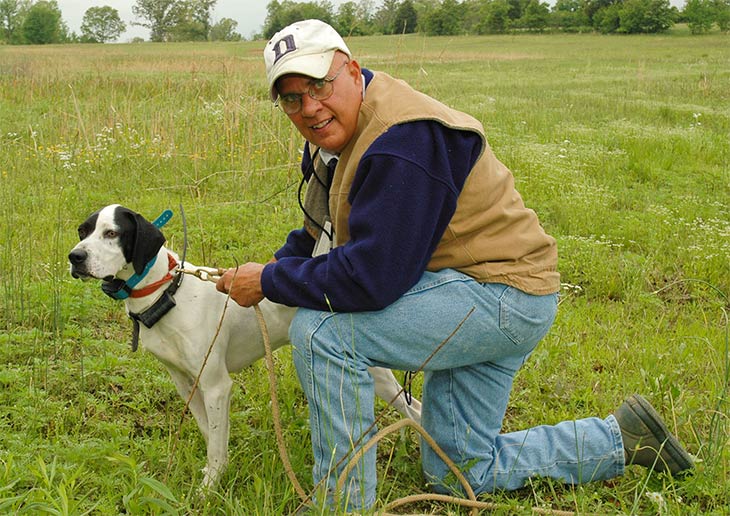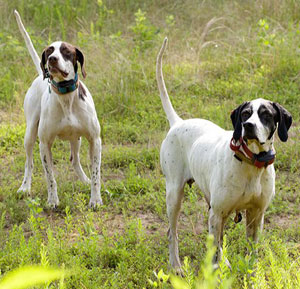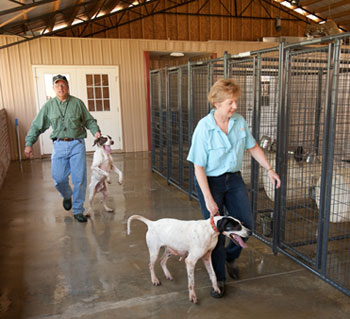Young and inexperienced, the white-and-black English pointer burned an indelible image in Dr. Thomas Morgan's memory as he watched her track quail across a wide swath of land in North Dakota.
After sprinting down a butte, racing across a meadow and paddling across a river, Hannabell — barely visible to Morgan on horseback atop the butte — dashed along the edge of a cornfield. Then she jolted to a dead stop.

Thomas Morgan with Rascal
Photo by Sheryl Smith-Rodgers
“I will never, ever forget how breathtaking that was, when Hannabell jumped up in the air, turned 180 degrees and went on point,” Morgan marvels. “That was truly the most athletic thing I’d ever seen any human or animal do in my whole life.”
Not surprisingly, Hannabell — a descendant of the world-famous Elhew English pointers — would go on to win countless competitions and break historic records among champion shooting dogs. Like his mother, son Offlee Amazin was bound for success, too.
As for Morgan, that unforgettable memory of Hannabell in September 2003 more than awed him. It also changed the direction of the life that he and his wife, Dr. Robin Morgan, shared in Colorado Springs, Colo.
“If I hadn’t watched Hannabell that day, we wouldn’t have bought this place in Mississippi three years later and moved here,” says Morgan, a semi-retired spine specialist with Semmes-Murphey Neurologic and Spine Institute in Memphis, Tenn. Dr. Robin Morgan is a pediatric neurologist with the Le Bonheur Children’s Medical Center and St. Jude’s Children’s Research Hospital in Memphis.
Family of Dog Lovers
From the start, dogs have always been an integral part of Morgan’s life.
“My father, George Morgan, raised bird dogs and beagles,” he says. “In fact, the day I was born, he had a three-week-old litter of English pointers in the whelping box with their mother. So I’ve never spent one day of my life without a good bird dog.” During their 18 years as doctors in Colorado, he and Robin lived on a ranch, where they bred horses, cattle, chocolate Labs and bird dogs. “I’ve always been an extremely conscientious breeder, whose No. 1 goal in breeding any animal is to improve the gene pool,” he says. “But back then, I was interested in just raising good gun dogs.”
Not for long, though.

Offlee Amazin, left, 2010 Purina Top Shooting Dog Field Trial winner, and his mother, Hannabell
Photo by Steve Jones
“Shawn had been after me to buy Hannabell,” Morgan says. “After I saw her — from the top of that butte — stop, turn on a dime and point, I looked at Shawn and said, ‘I’m in.’ But I had no clue what I was getting into!”
By her second competitive season in 2005, Hannabell missed winning the Purina Top Shooting Dog Award by 90 points. The following year, she easily snagged the title with more than 3,000 points, a new record for an English pointer.
Joining the Field-Trial Family
“After Hannabell joined our family, Robin and I became part of the field-trial family,” Morgan says. “We began to think of retiring and looking for a plantation to buy.”
For nine months, the couple searched for just the right location. “We wanted to live in the historical bird dog country, like western Tennessee or northern Mississippi,” Robin says, “so Thomas could raise puppies and train bird dogs in the right kind of habitat.”
In 2006, the Morgans purchased the 1,000-acre Wilson Dunn Plantation near Holly Springs, Miss., and renamed it Covey Rise Plantation. Joe Hill, vice president and branch manager with the Mississippi Land Bank in Senatobia, assisted the couple in closing the deal.
“We wanted to refinance and get a loan with more favorable terms,” Robin says. “Because we had so much land, other banks didn’t want to help us. Joe, though, understands the needs of farmers and people with large acreage. Everyone with the Land Bank was upfront and honest. Working with them made the whole process very quick, easy, efficient and pleasant.”
The land, though, presented different challenges. Once heavily farmed and since overgrown with thick forests and invasive kudzu, it was far from being the prime quail habitat that Morgan needed to train his dogs. Determined, he set to work to restore both the habitat and quail populations.
“You couldn’t see 10 feet into the trees because the growth was so solid,” he says. “In many places, we performed a select or ‘plantation’ thinning of the trees. We planted plum thickets, native shortgrasses, partridge pea and sorghum. I also disked several fields and planted strips of bicolor lespedeza. The plum thickets and the lespedeza are ‘quail headquarters’ because the birds have a good food source and protection from predators.”
The Making of a Champion
Three times or more a week, Morgan trains and exercises his 12 English pointers. On a cool May morning, he takes Rascal, one of Hannabell’s 18-month-old puppies, out for a session. First, Morgan fastens two collars — one with a shock device, the other with a Global Positioning System transmitter — onto the dog’s neck.
“These GPS trackers have revolutionized bird dog training,” Morgan explains. “Now we can find our dogs if they run off or begin chasing deer. I only use a shock collar as a last resort. I primarily use my voice to direct my dogs.
“Hey, buddy!” Morgan calls to the excited dog, “Think you can find some birds?” With one last bark, Rascal shoots across the freshly mowed grass and down a sloping hill, where he races along an edge of brush and grass. “Easy now, Rascal, easy. Hut, hut!” calls Morgan, who’s driving a dusty Polaris behind the dog.
“He’s searching for the bird’s ‘scent cone,’” the doctor says. “Not many people know or understand the scent cone, which starts with the maximum concentration of odor from the bird at the cone’s vertex and moves away to the cone’s base.

Drs. Thomas and Robin Morgan return their energetic champions to the kennels after a morning hunt.
Photo by Steve Jones
“A dog must hit the cone at some point before he can find the bird,” he continues. “So wind direction, wind speed, temperature, humidity and the dog’s scenting abilities all play a role in a successful point or ‘find.’”
It’s not long before Rascal stands stiffly poised, nose pointed toward a homing pigeon that Morgan has hidden in the grass. “Atta boy, atta boy!” he praises. Gently, he smoothes the dog’s back and strokes his “twelve o’clock” tail.
“A good bird dog must be stylish and well-mannered,” he explains quietly. “He has to learn, against his instincts, to be steady to wing and shot and not to prematurely cause the covey rise.”
Breaking Records, Making History
Rascal has a tough lead to follow his mother, Hannabell, who garnered 19 professional horseback championships in her six-year career. The accomplishment breaks all records set by any dog of all breeds since the sport began in 1897. She is also a two-time winner of the Purina Top Shooting Dog of the Year award (2006 and 2008). At age 10, Hannabell, who retired after the 2009-10 season, also won the National Endurance Open Championship.
In a photo finish, Offlee Amazin edged out his mother, Hannabell, to win this year’s Top Shooting Dog Field Trial Award. “It literally came down to the last field trial of the year, and it could have been a 10-year-old mother or her four-year-old son who came out on top,” Morgan explains. “Robin and I would have been happy either way.”
In early June, Purina Mills flew the Morgans and Offlee Amazin to Valdosta, Ga., for the annual awards ceremony. Among their prizes was an original oil painting of Offlee Amazin, by wildlife artist Ross Young. This year, the young pointer also outperformed 80 other top dogs to win the prestigious 2010 National Open Shooting Dog Championship.
“This has been an exceptional year for both dogs and Shawn,” Morgan says. “We are beyond lucky to have them all in our family. And we’re also very humbled by all of this.”
– Sheryl Smith-Rodgers
POINTERS: Models of Agility and Grace
A pointing breed is a type of gundog typically used in finding game. Gundogs are usually divided into three classes: retrievers, flushing dogs and point breeds. The name pointer comes from the dog’s instinct to point, by stopping and aiming its muzzle toward game. This demonstrates to the hunter the location of the quarry and allows them to move into gun range.
Pointers have been selectively bred for the sport of hunting, as evidenced by their noble stance, muscular body, intelligent expression and seemingly unending desire to go. The ideal pointer gives the immediate impression of compact power and agile grace. In addition, the dog’s even temperament and alert good sense make him a congenial companion both in the field and in the home.
Like many breeds, their history is debatable, but they first appeared in England around 1650 and were the first breed used to stand game.